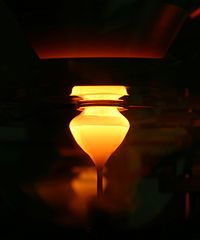Float-zone silicon

Float-zone silicon is a type of material that is used to make computer chips and other electronic components. It is made by starting with a block of silicon and melting it using extremely high temperatures.
Once the silicon is molten, a small crystal is introduced into the middle of the liquid. This crystal acts as a sort of template for the silicon to grow around.
As the silicon slowly cools, it forms a long, cylindrical crystal that stretches from one end of the molten material to the other. This is called a "float zone," because the crystal floats in the liquid and grows as the material slowly moves through the furnace.
The resulting crystal is very pure and free from defects, making it ideal for use in electronics. It has a very high resistance to electricity, making it a good insulator, and it can also conduct electricity under certain conditions.
Overall, float-zone silicon is an important material used in the production of high-quality electronics, and its purity and unique properties make it a valuable resource in the field.
Once the silicon is molten, a small crystal is introduced into the middle of the liquid. This crystal acts as a sort of template for the silicon to grow around.
As the silicon slowly cools, it forms a long, cylindrical crystal that stretches from one end of the molten material to the other. This is called a "float zone," because the crystal floats in the liquid and grows as the material slowly moves through the furnace.
The resulting crystal is very pure and free from defects, making it ideal for use in electronics. It has a very high resistance to electricity, making it a good insulator, and it can also conduct electricity under certain conditions.
Overall, float-zone silicon is an important material used in the production of high-quality electronics, and its purity and unique properties make it a valuable resource in the field.
Related topics others have asked about:
